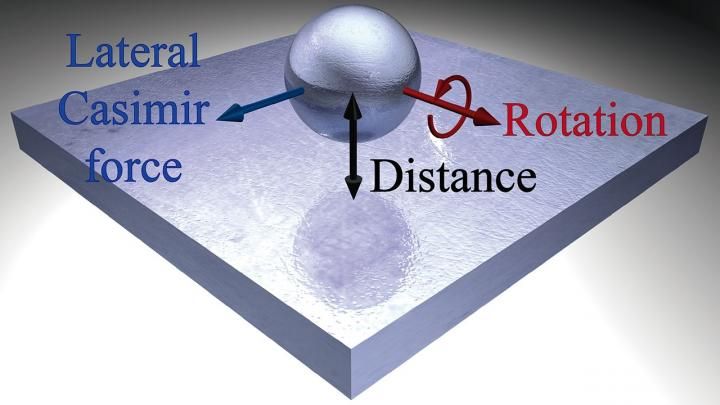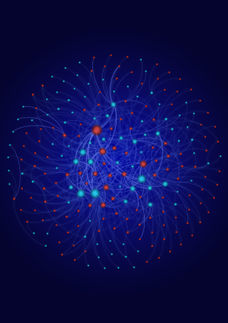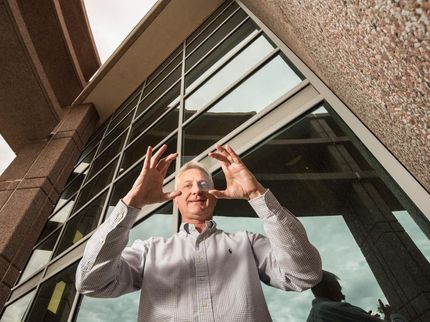Strange forces acting on nanoparticles discovered
A new scientific paper published, in part, by a University of New Mexico physicist is shedding light on a strange force impacting particles at the smallest level of the material world.

This illustration shows a nanoparticle rotating above a planar surface before experiencing a lateral Casimir force.
Dr. Alejandro Manjavacas
The discovery was made by an international team of researchers lead by UNM Assistant Professor Alejandro Manjavacas in the Department of Physics & Astronomy. Collaborators on the project include Francisco Rodríguez-Fortuño (King's College London, U.K.), F. Javier García de Abajo (The Institute of Photonic Sciences, Spain) and Anatoly Zayats (King's College London, U.K.).
The findings relate to an area of theoretical nanophotonics and quantum theory known as the Casimir Effect, a measurable force that exists between objects inside a vacuum caused by the fluctuations of electromagnetic waves. When studied using classical physics, the vacuum would not produce any force on the objects. However, when looked at using quantum field theory, the vacuum is filled with photons, creating a small but potentially significant force on the objects.
"These studies are important because we are developing nanotechnologies where we're getting into distances and sizes that are so small that these types of forces can dominate everything else," said Manjavacas. "We know these Casimir forces exist, so, what we're trying to do is figure out the overall impact they have very small particles."
Manjavacas' research expands on the Casimir effect by developing an analytical expression for the lateral Casimir force experienced by nanoparticles rotating near a flat surface.
Imagine a tiny sphere (nanoparticle) rotating over a surface. While the sphere slows down due to photons colliding with it, that rotation also causes the sphere to move in a lateral direction. In our physical world, friction between the sphere and the surface would be needed to achieve lateral movement. However, the nano-world does not follow the same set of rules, eliminating the need for contact between the sphere and the surface for movement to occur.
"The nanoparticle experiences a lateral force as if it were in contact with the surface, even though is actually separated from it," said Manjavacas. "It's a strange reaction but one that may prove to have significant impact for engineers."
While the discovery may seem somewhat obscure, it is also extremely useful for researchers working in the always evolving nanotechnology industry. As part of their work, Manjavacas says they've also learned the direction of the force can be controlled by changing the distance between the particle and surface, an understanding that may help nanotech engineers develop better nanoscale objects for healthcare, computing or a variety of other areas.
For Manjavacas, the project and this latest publication are just another step forward in his research into these Casimir forces, which he has been studying throughout his scientific career. After receiving his Ph.D. from Complutense University of Madrid (UCM) in 2013, Manjavacas worked as a postdoctoral research fellow at Rice University before coming to UNM in 2015.
Currently, Manjavacas heads UNM's Theoretical Nanophotonics research group, collaborating with scientists around the world and locally in New Mexico. In fact, Manjavacas credits Los Alamos National Laboratory Researcher Diego Dalvit, a leading expert on Casimir forces, for helping much of his work progress.
"If I had to name the person who knows the most about Casimir forces, I'd say it was him," said Manjavacas. "He published a book that's considered one of the big references on the topic. So, having him nearby and being able to collaborate with other UNM faculty is a big advantage for our research."
Original publication
Other news from the department science
These products might interest you

NANOPHOX CS by Sympatec
Particle size analysis in the nano range: Analyzing high concentrations with ease
Reliable results without time-consuming sample preparation

Eclipse by Wyatt Technology
FFF-MALS system for separation and characterization of macromolecules and nanoparticles
The latest and most innovative FFF system designed for highest usability, robustness and data quality

DynaPro Plate Reader III by Wyatt Technology
Screening of biopharmaceuticals and proteins with high-throughput dynamic light scattering (DLS)
Efficiently characterize your sample quality and stability from lead discovery to quality control

Get the chemical industry in your inbox
By submitting this form you agree that LUMITOS AG will send you the newsletter(s) selected above by email. Your data will not be passed on to third parties. Your data will be stored and processed in accordance with our data protection regulations. LUMITOS may contact you by email for the purpose of advertising or market and opinion surveys. You can revoke your consent at any time without giving reasons to LUMITOS AG, Ernst-Augustin-Str. 2, 12489 Berlin, Germany or by e-mail at revoke@lumitos.com with effect for the future. In addition, each email contains a link to unsubscribe from the corresponding newsletter.





























































